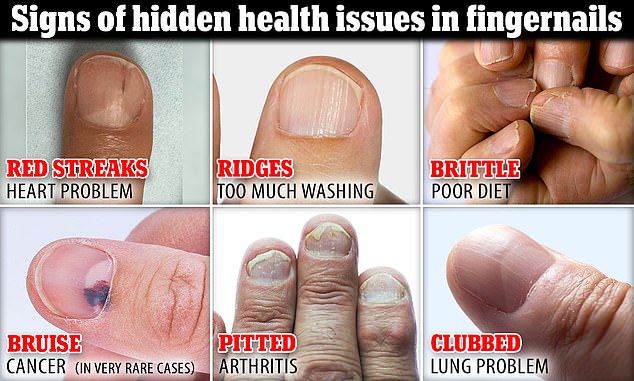Bizarre white lines on man’s fingernails turned out to be a sign of his CANCER drugs – as doctors say nails can be a window into your health
A cancer patient became concerned when he started developing unexplained white lines across his fingernails.
The 30-year-old man said the horizontal lines appeared across his nail beds around the same time he was diagnosed with lymphoma and about halfway through this chemotherapy protocol.
After his doctors performed a physical examination, they discovered that the six lines on each nail corresponded to each of the patient's six chemotherapy treatments.
The man was diagnosed with transverse leukonychia, also known as Mees' lines, a benign condition that causes nail lines and a side effect of some chemotherapy drugs.
Although the patient's nail changes turned out to be harmless, spots, bruises, and lines in the fingernails may actually be signs of cancer itself.
Upon examining the patient's nails, doctors saw six horizontal lines across the nails of both hands and determined that he had transverse leukonychia, also known as Mees' lines.

The image above highlights six nail changes that could indicate a serious problem in the body
Fingernails are made up largely of a hardened protein called keratin – the same protein found in the claws and horns of animals. Keratin is also found in human hair and skin.
Nail changes are a common side effect of chemotherapy, sometimes called “chemo nails” because some medications interrupt the proper function of the group of cells responsible for making new nails.
These changes occur in about 40 percent of patients.
This is similar to the effect chemotherapy has on hair, where some drugs cause chemo patients to go bald because the drugs damage fast-growing cells and damage hair follicles, leading to hair loss.
Less than a year later, the patient's nails returned to normal case was detailed in the New England Journal of Medicine.
Whether it's a sign of heart problems, arthritis, or circulatory problems, fingernails can reveal a range of important health information.
Dr. Shari Lipner, a dermatologist from Cornell University in New York City, previously told DailyMail.com that nails can be a “canary in the coal mine” for a serious problem in the body.
She said: 'It is essential that people examine their nails themselves about once a month, in addition to calling on dermatologists.'
In addition to horizontal lines, vertical lines can also appear on the fingernails, also called subungual melanoma. These lines are benign and are a natural sign of aging.
But they can also indicate too much hand washing or excessive use of hand disinfectants.
While people have gotten into the habit of excessive hand washing and using sanitizer several times a day during the Covid-19 pandemic, overusing it can cause excessive dry skin and remove healthy oils and bacteria that protect against infections, affecting your hands become vulnerable to infections.
In rare cases, your fingernails may even indicate cancer. That seemingly innocent blue or purple spot under your nail may not be an insignificant bruise.
Skin cancer can develop under the nails, causing a black or dark-colored spot that does not go away.
While a bruise from getting your finger stuck in the door will disappear as your nail grows, a skin cancer spot will not disappear and the normal-looking nail color will eventually not penetrate.
Skin cancer under the nail, called subungual melanoma, is extremely rare and very treatable if caught early.
When red streaks appear on the fingernails, keep a close eye on them. These discolorations can be the result of a bruise or trauma to the nail, but they can also be early warning signs of a life-threatening infection of the heart called bacterial endocarditis, in which microorganisms infect the heart valves.
This happens when bacteria or other germs enter the bloodstream and travel to the heart.
Dr. Lipner told DailyMail.com that if the condition is left untreated, it is “not unusual for the nails to be the first clue.”
Also a warning sign of a possible heart problem: bruised nails.
Doctors warn that having bruised fingernails may be due to a lack of oxygen in the blood or circulatory problems. Both can be a warning sign that the heart and lungs are not functioning properly.
This can cause blood to pool in the tips of the limbs, causing the nails to curve over the sides of the fingers, creating a club-like appearance.
Do you suffer from brittle or breaking nails? You might want to take a look at what you eat. A poor diet can lead to a deficiency of iron in the body, which can cause nails to become ridged and brittle, making them more likely to split, peel or crumble.
To prevent this, doctors recommend a well-rounded diet, full of nutrient-rich foods.
To proactively monitor nail health, removing nail polish from your nails can help your dermatologist examine your doctor's recommended annual skin check for any warning signs.
Periodic self-examination of the fingernails is also recommended by a doctor.
